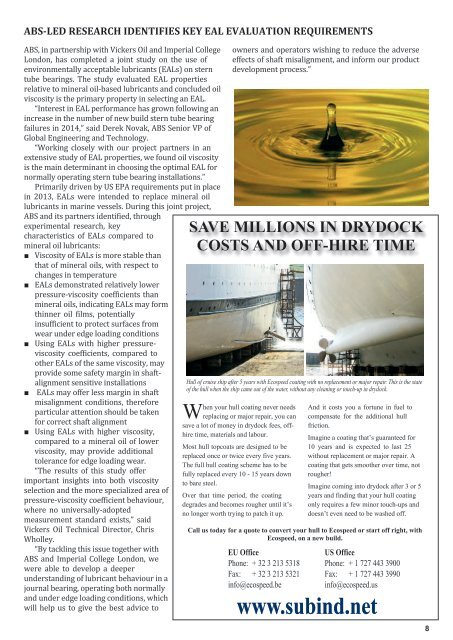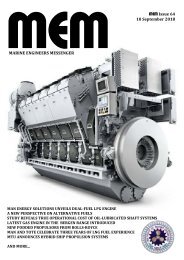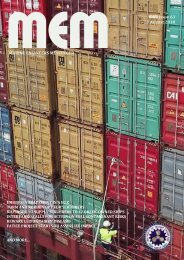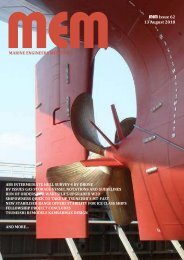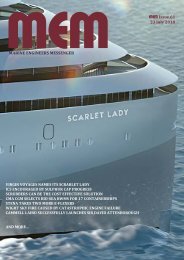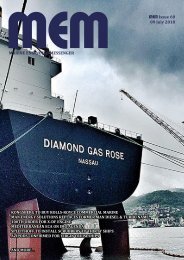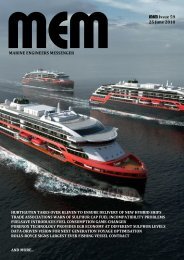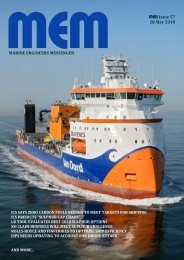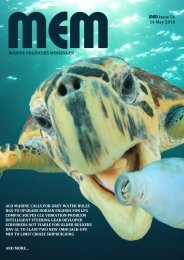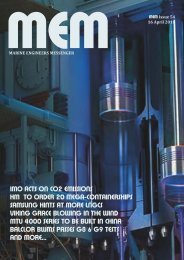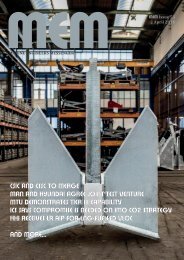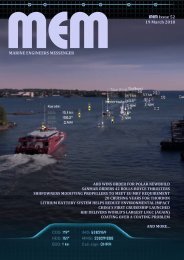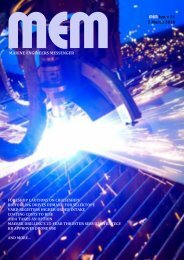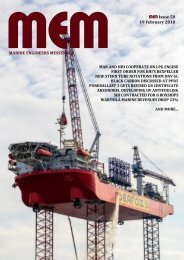You also want an ePaper? Increase the reach of your titles
YUMPU automatically turns print PDFs into web optimized ePapers that Google loves.
ABS-LED RESEARCH IDENTIFIES KEY EAL EVALUATION REQUIREMENTS<br />
ABS, in partnership with Vickers Oil and Imperial College<br />
London, has completed a joint study on the use of<br />
environmentally acceptable lubricants (EALs) on stern<br />
tube bearings. The study evaluated EAL properties<br />
relative to mineral oil-based lubricants and concluded oil<br />
viscosity is the primary property in selecting an EAL.<br />
“Interest in EAL performance has grown following an<br />
increase in the number of new build stern tube bearing<br />
failures in 2014,” said Derek Novak, ABS Senior VP of<br />
Global Engineering and Technology.<br />
“Working closely with our project partners in an<br />
extensive study of EAL properties, we found oil viscosity<br />
is the main determinant in choosing the optimal EAL for<br />
normally operating stern tube bearing installations.”<br />
Primarily driven by US EPA requirements put in place<br />
in 2013, EALs were intended to replace mineral oil<br />
lubricants in marine vessels. During this joint project,<br />
ABS and its partners identified, through<br />
experimental research, key<br />
characteristics of EALs compared to<br />
mineral oil lubricants:<br />
■ Viscosity of EALs is more stable than<br />
that of mineral oils, with respect to<br />
changes in temperature<br />
■ EALs demonstrated relatively lower<br />
pressure-viscosity coefficients than<br />
mineral oils, indicating EALs may form<br />
thinner oil films, potentially<br />
insufficient to protect surfaces from<br />
wear under edge loading conditions<br />
■ Using EALs with higher pressureviscosity<br />
coefficients, compared to<br />
other EALs of the same viscosity, may<br />
provide some safety margin in shaftalignment<br />
sensitive installations<br />
■ EALs may offer less margin in shaft<br />
misalignment conditions, therefore<br />
particular attention should be taken<br />
for correct shaft alignment<br />
■ Using EALs with higher viscosity,<br />
compared to a mineral oil of lower<br />
viscosity, may provide additional<br />
tolerance for edge loading wear.<br />
“The results of this study offer<br />
important insights into both viscosity<br />
selection and the more specialized area of<br />
pressure-viscosity coefficient behaviour,<br />
where no universally-adopted<br />
measurement standard exists,” said<br />
Vickers Oil Technical Director, Chris<br />
Wholley.<br />
“By tackling this issue together with<br />
ABS and Imperial College London, we<br />
were able to develop a deeper<br />
understanding of lubricant behaviour in a<br />
journal bearing, operating both normally<br />
and under edge loading conditions, which<br />
will help us to give the best advice to<br />
owners and operators wishing to reduce the adverse<br />
effects of shaft misalignment, and inform our product<br />
development process.”<br />
SAVE MILLIONS IN DRYDOCK<br />
COSTS AND OFF-HIRE TIME<br />
Hull of cruise ship after 5 years with Ecospeed coating with no replacement or major repair. This is the state<br />
of the hull when the ship came out of the water, without any cleaning or touch-up in drydock.<br />
When your hull coating never needs<br />
replacing or major repair, you can<br />
save a lot of money in drydock fees, offhire<br />
time, materials and labour.<br />
Most hull topcoats are designed to be<br />
replaced once or twice every five years.<br />
The full hull coating scheme has to be<br />
fully replaced every 10 - 15 years down<br />
to bare steel.<br />
Over that time period, the coating<br />
degrades and becomes rougher until it’s<br />
no longer worth trying to patch it up.<br />
And it costs you a fortune in fuel to<br />
compensate for the additional hull<br />
friction.<br />
Imagine a coating that’s guaranteed for<br />
10 years and is expected to last 25<br />
without replacement or major repair. A<br />
coating that gets smoother over time, not<br />
rougher!<br />
Imagine coming into drydock after 3 or 5<br />
years and finding that your hull coating<br />
only requires a few minor touch-ups and<br />
doesn’t even need to be washed off.<br />
Call us today for a quote to convert your hull to Ecospeed or start off right, with<br />
Ecospeed, on a new build.<br />
EU Office<br />
Phone: + 32 3 213 5318<br />
Fax: + 32 3 213 5321<br />
info@ecospeed.be<br />
US Office<br />
Phone: + 1 727 443 3900<br />
Fax: + 1 727 443 3990<br />
info@ecospeed.us<br />
www.subind.net<br />
8


